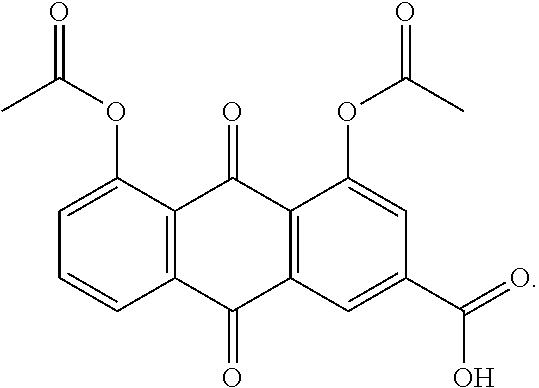Methods of decreasing glycosylated hemoglobin in patients with dyslipidemia
a glycosylated hemoglobin and dyslipidemia technology, applied in the field of dyslipidemia patients, can solve the problem that no literature has reported that il-1 modulators can improve glycosylated hemoglobin, and achieve the effect of decreasing abnormal blood hba1c levels
- Summary
- Abstract
- Description
- Claims
- Application Information
AI Technical Summary
Benefits of technology
Problems solved by technology
Method used
Image
Examples
example 1
A Randomized, Double-Blind, Placebo-Controlled Study of Diacerin in Patients with Uncontrolled Type 2 Diabetes Mellitus
[0041]Objectives:
[0042]To evaluate the efficacy and safety of diacerin for the treatment of type 2 diabetes mellitus (DM).
[0043]Primary Endpoints:
[0044]To compare the efficacy of add-on diacerin with no add-on treatment (placebo) on HbA1c after 24-week double-blind treatment in Type 2 DM patients inadequately controlled by previous antidiabetic therapy.
[0045]Subjects:
[0046]Male or female patients (BMI≦35 kg / m2) with type 2 diabetes mellitus on a stable oral hypoglycemic monotherapy for at least 3 months prior to screening visit. The HbA1c measurements taken at screening visit must be between 7% and 12%. Patients enrolled in the study must be receiving one or more oral antihyperglycemic agents including sulfonylurea, biguanides, alpha-glucosidase inhibitors, thiazolidinediones, and nonsulfonylurea insulin secretagogues.
[0047]Procedure:
[0048]This was a prospective, ra...
PUM
| Property | Measurement | Unit |
|---|---|---|
| concentrations | aaaaa | aaaaa |
| concentration | aaaaa | aaaaa |
| β-cell function | aaaaa | aaaaa |
Abstract
Description
Claims
Application Information
 Login to View More
Login to View More - R&D
- Intellectual Property
- Life Sciences
- Materials
- Tech Scout
- Unparalleled Data Quality
- Higher Quality Content
- 60% Fewer Hallucinations
Browse by: Latest US Patents, China's latest patents, Technical Efficacy Thesaurus, Application Domain, Technology Topic, Popular Technical Reports.
© 2025 PatSnap. All rights reserved.Legal|Privacy policy|Modern Slavery Act Transparency Statement|Sitemap|About US| Contact US: help@patsnap.com


